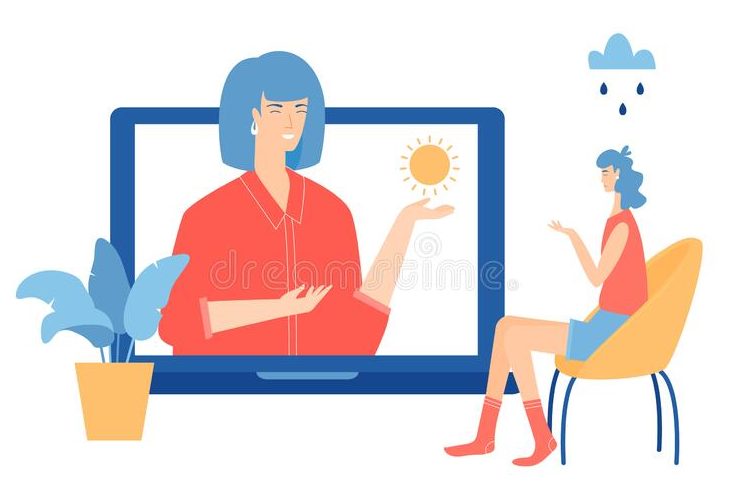
“If you never learn anything new, you’ll never be anything different”
The neuro-divergent community which includes people with disabilities and special needs have been fighting for their rights and accessibility for a really long time now, but the recent lockdown has made it obvious to all. Similarly, the existence of teletherapy has been omnipresent for quite some time but it wasn’t preferred until now. We have seen the dependency on digital modalities of communication in this coronavirus induced lockdown. As experts say, social distancing is here to stay for at least another year to eliminate the risks of further community transmission, due to which more numbers of people will turn to choose teletherapy for all their health concerns. For those who have already taken this leap, teletherapy is likely to remain the preferred mode of support for the next few years. Several research studies are showing the effectiveness of teletherapy for children with special needs and their positive impact on them. So the real question now is What exactly is teletherapy?
Teletherapy
Teletherapy, also known as online therapy, e-therapy or video therapy, is therapy delivered through a virtual platform via a computer. During the lockdown, we have been using Zoom, Google Meet, Skype for connecting with our family and friends across the world. Teletherapy works in the same way, except that on the other side of the screen it is your therapist or counsellor conducting sessions for you. These virtual therapy sessions can be conducted by all the therapists and practitioners involved in the neurodiverse support system which includes but not limited to: speech therapy, behavioural therapy, physical therapy and psychological therapy. In times where physical distancing is the need of the hour, teletherapy has come to the forefront as the solution to this crisis.
How does Teletherapy exactly work?
For neurodivergent individuals, teletherapy works in the same way as traditional therapy with just one significant difference: the client and the therapist are not in the same room. In the case of synchronous teletherapy, scheduling of sessions at an appropriate time and day for each party takes place who then log in via an agreed, secure video platform. The therapist and client can see and hear each other in real-time during the session via the use of webcams and headsets. Through this virtual environment, they can interact with each other, and the therapist uses the same traditional techniques and activities they would use in a face-to-face therapy session.
So how does teletherapy benefit the Neurodivergent community especially now in the digital age where we are all forced to move to online modes of communication. Let’s find out!
Benefits of Teletherapy for Neurodivergent individuals
- BETTER EFFECTIVENESS OF TELETHERAPY IN INDIVIDUALS WITH AUTISM
There are multifaceted ongoing research projects which point to the effectiveness of teletherapy for children with autism and other learning differences. Conducting therapy sessions via an online portal like a laptop/computer/iPad/phone can be less intimidating for an individual with autism, thus increasing interaction and participation with therapy. It has been observed that social anxiety levels can lower during teletherapy sessions. Computer-based intervention may be the best modality for therapy for certain children, young adults, or adults on the spectrum and may result in reaching the desired outcomes and goals quicker. Different kinds of teletherapy activities can be conducted for both verbal and non-verbal children with autism, to help them improve their social skills and communication techniques. The development and usage of social stories via teletherapy using different characters, animations, voices can also be more effective, engaging all the senses of the child, hence showing faster progress.
- EVIDENCE-BASED PRACTICE CAN BE CARRIED OUT VIA TELETHERAPY
It was a common belief that evidence-based practice is eliminated in teletherapy, however, this is not true. Therapists can provide different types of evidence-based therapy focusing on a variety of goals like social, communication, motivational goals. If a child is non-verbal and would benefit from an alternative mode of communication, the speech therapist can work towards setting up a Picture Exchange Communication System (PECS) Board, entirely via teletherapy. This can help the child pick up communication tricks faster and more efficiently.
- GROUPING OF MULTIPLE THERAPY TECHNIQUES POSSIBLE
Different therapy sessions can be merged together to create a multi-disciplinary model of therapeutic intervention for children who need to learn a particular skill differently. In teletherapy, various therapists can work together and collaborate with the parents to create an individualized therapy session, flexible enough to help individuals with autism receive the desired amount of therapy across services.
- GREATLY CAPTURES THE INTEREST OF A NEURODIVERGENT INDIVIDUAL
Teletherapy isn’t only counselling and therapy sessions, it also involves a lot of learning and understanding for a child with special needs. Different kinds of audio-visual simulations roleplay of real-life situations, textual graphics and tools can be used to make this kind of therapy more interesting and engaging for children.
- SAVING OF TIME AND MEETING TIMELINES
Teletherapy sessions can begin at the click of a button. Without problems like being stuck in a traffic jam, timeliness is significantly improved when clients are always in reach of their devices. For clients who live far away, travel time is a huge concern. With teletherapy, things are easier and more accessible. On the other hand, unexpected traffic closures often lead to inconvenience for both the clients and the therapists making the therapy sessions slightly ineffective with the add-on delays. Tele-therapy takes care of these concerns and helps in managing the time well for the neuro-divergent individual as well as reduce anxiety levels among their parents and caregivers.




You must be logged in to post a comment.